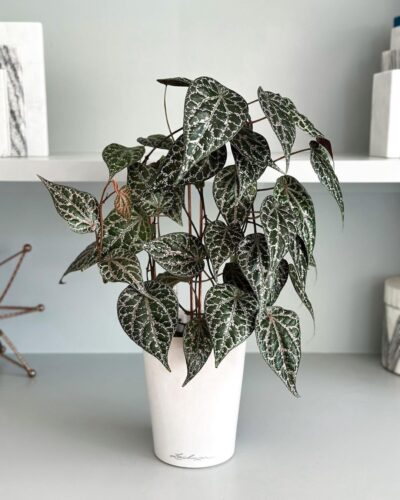Piper Ornatum is a beautiful vining shrub with shiny olive-green veined foliage. You can grow this houseplant in hanging baskets indoors.
If you’re looking to add a unique and beautiful houseplant to your indoor collection, Piper Ornatum or Ornamental Pepper Vine is a great choice. This plant is relatively easy to care for and can thrive indoors with the right growing conditions. Learn more in the below post.
Common Name: Celebes Pepper, Red Betel, Ornamental Pepper Vine, Ornate Pepper Plant
Botanical Name: Piper Ornatum
USDA Zones: 8-11
Read: Anthurium Crystallinum Care
Piper Ornatum Plant

The Ornamental Pepper Vine, also known as Celebes Pepper, is a sprawling vining shrub from Indonesia; it grows low to the ground. It features heart or teardrop-shaped glossy olive green leaves that are mottled with silver to pink venation.
You can use Celebes Pepper as a houseplant by planting it in a hanging basket, allowing it to dangle down, or training it to climb up using a moss pole or trellis. It also looks beautiful in terrariums since it loves humidity.
How to Propagate Piper Ornatum
Propagating Piper Ornatum is an easy process that involves stem cuttings.
- Take a cutting that is 5 to 7 inches long, making the cut below a node, which is a small bump on the stem where new roots will grow.
- Place the cutting in a pot filled with regular potting mix and moisten the soil.
- Keep the pot in an area that receives plenty of dappled light.
- New growth should appear within 3-5 weeks.
- It is important to ensure that the weather is warm and suitable for propagation when taking the cutting.
Ideal Growing Conditions for Piper Ornatum Indoors
Light
The light requirements of Piper Ornatum match average household settings.
While the plant can tolerate some shade, the color and luster of the foliage may not be as vibrant if it’s not exposed to enough light. To ensure the plant looks its best, it’s recommended to place it where it can receive some morning sun for 3-4 hours. This will enhance the plant’s color.
However, it’s important to protect the plant from the harsh afternoon sun. The best location for growing this plant is where it can receive filtered sunlight both indoors and outdoors.
Soil
Use well-draining soil for Piper Ornatum, as it does not tolerate sitting in a waterlogged growing medium.
The pH level of the soil should be between 6 to 7, ranging from acidic to alkaline. If the soil is too acidic, you can add lime to raise the pH level. Conversely, if the soil is too alkaline, you can add sulfur to lower the pH level.
Watering
Ornamental Piper Vine is sensitive to overwatering but still prefers a slightly moist growing medium. Water the plant when the topsoil feels dry to the touch. However, it’s important to avoid letting the soil become completely dry.
If you notice that the leaves are turning yellow and mushy, it indicates that the plant has been overwatered. On the other hand, brown and papery foliage is a sign that the soil is too dry.
Temperature and Humidity
Piper Ornatum Vine favors warm and humid conditions with consistent temperatures, as it is a plant that prefers a tropical climate. The ideal temperature range for this plant is between 65-90 F (18-32 C), and it’s important to ensure that the surroundings do not dip below 50 F (10 C).
During dry air seasons, you can increase the humidity around the plant by placing its pot on a tray of pebbles filled with water or by using a humidifier.
Read: Ficus pumila quercifolia Care
Piper Ornatum Care Indoors

Fertilizer
This plant is not a heavy feeder. Use any balanced liquid fertilizer with equal N-P-K and dilute it to one-fourth of its recommended strength. Feed the plant with this solution once every few weeks.
Additionally, applying Epsom salt occasionally can be beneficial. Mix half a teaspoon of Epsom salt with 600 ml of water and use it to water this and other houseplants.
Note: It’s best to stop feeding the plant when the nighttime temperature starts to decrease and resume fertilization when it warms up.
Re-potting
It’s important to re-pot the plant when you notice the roots filling up more than the volume of soil or coming out from the drainage holes of the pot. The ideal time to do this is during the spring or summer, and it’s best to choose a container that is one size bigger or 1 or 2 inches larger than the previous one.
Handle the plant with care and avoid disturbing or breaking the root ball during repotting. Use fresh potting soil to ensure optimal growth.
Pests and Diseases
Overwatering can cause root rot, which is the most common disease that infects the plant. Additionally, the plant is vulnerable to aphids and spider mites, which can pose a threat, so it is important to be cautious of them.
Use of Piper ornatum
People in the Indian subcontinent have used Piper Ornatum as a folk medicine to treat various diseases. However, it is important to consult your medical practitioner before using it.
Toxicity
Keeping this Celebes Pepper plant out of the reach of dogs and cats is important as it can be mildly toxic to them. The toxicity symptoms include drooling, nausea, or vomiting if consumed in excessive amounts.
Read: Hoya Lyi Care



